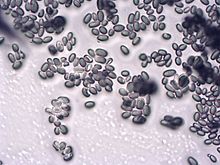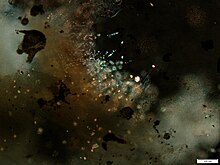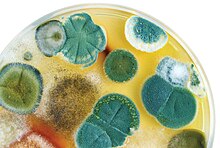Mold
A mold ().
A large and
Molds are considered to be
Molds cause biodegradation of natural materials, which can be unwanted when it becomes food spoilage or damage to property. They also play important roles in biotechnology and food science in the production of various pigments, foods, beverages, antibiotics, pharmaceuticals and enzymes.[9] Some diseases of animals and humans can be caused by certain molds: disease may result from allergic sensitivity to mold spores, from growth of pathogenic molds within the body, or from the effects of ingested or inhaled toxic compounds (mycotoxins) produced by molds.[1]
Biology
There are thousands of known species of mold fungi with diverse life-styles including
Molds reproduce by producing large numbers of small
Although molds can grow on dead organic matter everywhere in nature, their presence is visible to the unaided eye only when they form large colonies. A mold colony does not consist of discrete organisms but is an interconnected network of hyphae called a mycelium. All growth occurs at hyphal tips, with cytoplasm and organelles flowing forwards as the hyphae advance over or through new food sources. Nutrients are absorbed at the hyphal tip. In artificial environments such as buildings, humidity and temperature are often stable enough to foster the growth of mold colonies, commonly seen as a downy or furry coating growing on food or other surfaces.
Few molds can begin growing at temperatures of 4 °C (39 °F) or below, so food is typically refrigerated at this temperature. When conditions do not enable growth to take place, molds may remain alive in a dormant state depending on the species, within a large range of temperatures. The many different mold species vary enormously in their tolerance to temperature and humidity extremes. Certain molds can survive harsh conditions such as the snow-covered soils of Antarctica, refrigeration, highly acidic solvents, anti-bacterial soap and even petroleum products such as jet fuel.[12]: 22
Xerophilic molds are able to grow in relatively dry, salty, or sugary environments, where water activity (aw) is less than 0.85; other molds need more moisture.[13]
Common molds

Common
Food production
The Kōji (麹) molds are a group of
Some sausages, such as salami, incorporate starter cultures of molds [17] to improve flavor and reduce bacterial spoilage during curing. Penicillium nalgiovense, for example, may appear as a powdery white coating on some varieties of dry-cured sausage.
Other molds that have been used in food production include:
- Fusarium venenatum – quorn
- Geotrichum candidum – cheese
- Neurospora sitophila – oncom
- Penicillium spp. – various cheeses including Brie and Blue cheese
- Rhizomucor miehei – microbial rennet for making vegetarian and other cheeses
- Rhizopus oligosporus – tempeh
- Rhizopus oryzae – tempeh, jiuqu for jiuniang or precursor for making Chinese rice wine
Pharmaceuticals from molds
Alexander Fleming's accidental discovery of the antibiotic penicillin involved a Penicillium mold called Penicillium rubrum (although the species was later established to be Penicillium rubens).[18][19][20] Fleming continued to investigate penicillin, showing that it could inhibit various types of bacteria found in infections and other ailments, but he was unable to produce the compound in large enough amounts necessary for production of a medicine.[21] His work was expanded by a team at Oxford University; Clutterbuck, Lovell, and Raistrick, who began to work on the problem in 1931. This team was also unable to produce the pure compound in any large amount, and found that the purification process diminished its effectiveness and negated the anti-bacterial properties it had.[21]
Several statin cholesterol-lowering drugs (such as lovastatin, from Aspergillus terreus) are derived from molds.[23]
The immunosuppressant drug
Health effects
Molds are ubiquitous, and mold spores are a common component of household and workplace dust; however, when mold spores are present in large quantities, they can present a health hazard to humans, potentially causing allergic reactions and respiratory problems.[24]
Some molds also produce mycotoxins that can pose serious health risks to humans and animals. Some studies claim that exposure to high levels of mycotoxins can lead to neurological problems and, in some cases, death.[25] Prolonged exposure, e.g. daily home exposure, may be particularly harmful. Research on the health impacts of mold has not been conclusive.[26] The term "toxic mold" refers to molds that produce mycotoxins, such as Stachybotrys chartarum, and not to all molds in general.[27]

Mold in the home can usually be found in damp, dark or steamy areas, e.g. bathrooms, kitchens, cluttered storage areas, recently flooded areas, basement areas, plumbing spaces, areas with poor ventilation and outdoors in humid environments. Symptoms caused by mold allergy are: watery, itchy eyes; a chronic cough; headaches or migraines; difficulty breathing; rashes; tiredness; sinus problems; nasal blockage and frequent sneezing.
Molds can also pose a hazard to human and animal health when they are consumed following the growth of certain mold species in stored food. Some species produce toxic secondary metabolites, collectively termed
Growth in buildings and homes
Mold growth in buildings generally occurs as fungi colonize porous building materials, such as wood.[29] Many building products commonly incorporate paper, wood products, or solid wood members, such as paper-covered drywall, wood cabinets, and insulation. Interior mold colonization can lead to a variety of health problems as microscopic airborne reproductive spores, analogous to tree pollen, are inhaled by building occupants. High quantities of indoor airborne spores as compared to exterior conditions are strongly suggestive of indoor mold growth.[30] Determination of airborne spore counts is accomplished by way of an air sample, in which a specialized pump with a known flow rate is operated for a known period of time. To account for background levels, air samples should be drawn from the affected area, a control area, and the exterior.
The air sampler pump draws in air and deposits microscopic airborne particles on a culture medium. The medium is cultured in a laboratory and the fungal genus and species are determined by visual microscopic observation. Laboratory results also quantify fungal growth by way of a spore count for comparison among samples. The pump operation time is recorded and when multiplied by pump flow rate results in a specific volume of air obtained. Although a small volume of air is actually analyzed, common laboratory reports extrapolate the spore count data to estimate spores that would be present in a cubic meter of air.[31]
Mold spores are drawn to specific environments, making it easier for them to grow. These spores will usually only turn into a full-blown outbreak if certain conditions are met.[32][33] Various practices can be followed to mitigate mold issues in buildings, the most important of which is to reduce moisture levels that can facilitate mold growth.[27] Air filtration reduces the number of spores available for germination, especially when a High Efficiency Particulate Air (HEPA) filter is used. A properly functioning AC unit also reduces the relative humidity in rooms.[34] The United States Environmental Protection Agency (EPA) currently recommends that relative humidity be maintained below 60%, ideally between 30% and 50%, to inhibit mold growth.[35]
Eliminating the moisture source is the first step at fungal remediation. Removal of affected materials may also be necessary for remediation, if materials are easily replaceable and not part of the load-bearing structure. Professional drying of concealed wall cavities and enclosed spaces such as cabinet toekick spaces may be required. Post-remediation verification of moisture content and fungal growth is required for successful remediation. Many contractors perform post-remediation verification themselves, but property owners may benefit from independent verification.
-
Moldy housecorner from outside and inside
-
Mold stains on a gift card with package which was stored unintentionally for six months in an open compartment in a motorcycle
Use in art
Various artists have used mold in various artistic fashions. Daniele Del Nero, for example, constructs scale models of houses and office buildings and then induces mold to grow on them, giving them an unsettling, reclaimed-by-nature look.[36] Stacy Levy sandblasts enlarged images of mold onto glass, then allows mold to grow in the crevasses she has made, creating a macro-micro portrait.[37] Sam Taylor-Johnson, director of Nowhere Boy and Fifty Shades of Grey (among others), has made a number of time-lapse films capturing the gradual decay of classically arranged still lifes.[38]
See also
- Bioaerosol – Airborne particles containing living organisms
- Decay – Process in which organic substances are broken down into simpler organic matter
- Indoor mold – Fungal growth that develops on wet materials
- Medicinal fungi– Fungi that can be used to develop medications
- Mildew – Form of fungus
- Mold mite– Species of mite
- Mycorrhiza – Fungus-plant symbiotic association
- Oomycete – Fungus-like eukaryotic microorganism
- Slime mold
- Water mold
References
- ^ ISBN 978-0521186957.
- OCLC 57001814.
- ^ Morgan, Mike. "Moulds". Microscopy UK. Archived from the original on 28 March 2019. Retrieved 26 June 2012.
- ^ Chiba University, Japan. "Fungus and Actinomycetes Gallery". Chiba University Medical Mycology Research Center. Archived from the original on 19 July 2012. Retrieved 26 June 2012.
- S2CID 4686378. Archived from the original(PDF) on 2009-03-26.
- ^ "Slime Molds". herbarium.usu.edu. Utah State University. Archived from the original on 20 February 2020. Retrieved 21 April 2020.
- ^ "Slime Molds: Myxomycetes" (PDF). Cornell University. Retrieved 21 April 2020.
- ^ "Introduction to the Oomycota". ucmp.berkeley.edu. UC Berkeley. Archived from the original on 6 May 2020. Retrieved 21 April 2020.
- PMID 34205202.
- ^ ISBN 978-0-8385-8529-0.
- ^ Wareing, Peter. "The Fungal Infection of Agricultural Produce and the Production of Mycotoxins". European Mycotoxins Awareness Network. Archived from the original on 19 October 2013. Retrieved 3 August 2013.
- ISBN 978-0-8020-2418-3.
- ISBN 978-0-387-92206-5.
- ^ "Red yeast rice (Monascus purpureus)". Mayo Clinic. 2009-09-01. Archived from the original on 2010-02-06. Retrieved 2010-02-01.
- National Public Radio. 2008-07-01. Archivedfrom the original on 2010-02-12. Retrieved 2010-02-01.
- ^ Red Yeast Rice Preparations: Are They Suitable Substitutions for Statins?, Dujovne, CA,Am J Med. 2017 Oct;130(10):1148-1150. doi: 10.1016/j.amjmed.2017.05.013. Epub 2017 Jun 7.
- PMID 22063673.
- ^ a b "The Nobel Prize website". Archived from the original on 19 May 2012. Retrieved 27 June 2012.
- PMID 22679592.
- PMID 23606767.
- ^ a b c d "Award Ceremony Speech". Nobel Prizes and Laureates. Nobel Media. Archived from the original on 27 May 2014. Retrieved 26 May 2014.
- ^ "Pfizer's work on penicillin for World War II becomes a National Historic Chemical Landmark". American Chemical Society. June 12, 2008. Archived from the original on August 8, 2016. Retrieved June 14, 2016.
- ISBN 9780080453828.
Lovastatin (also known as mevinolin) is produced by Aspergillus terreus
- PMID 12460818.
- S2CID 27769836.
- ISBN 978-0-19-517227-0.
- ^ a b Indoor Environmental Quality: Dampness and Mold in Buildings Archived 2020-05-07 at the Wayback Machine. National Institute for Occupational Safety and Health. August 1, 2008.
- ^ Saunders Comprehensive Veterinary Dictionary, Blood and Studdert, 1999
- ^ Fairey, Philip; Chandra, Subrato; Moyer, Neil. "Mold Growth". Florida Solar Energy Center. University of Central Florida. Archived from the original on 27 August 2019. Retrieved 19 August 2019.
- ^ IICRC S500 Standard and Reference Guide for Professional Water Damage Restoration
- ^ "Prestige EnviroMicrobiology, Inc". prestige-em.com. Archived from the original on 2017-03-01. Retrieved 2018-03-26.
- ^ "A Brief Guide to Mold, Moisture and Your Home". EPA. 13 August 2014.
- ^ "Mushroom Growth".
- ^ "Facts About Mold". www.aiha.org. Retrieved 2018-03-26.
- ^ "A Brief Guide to Mold, Moisture and Your Home". US EPA. 13 August 2014. Archived from the original on January 6, 2020. Click on "Moisture and Mold Prevention and Control Tips".
- ^ Solon, Olivia (30 November 2010). "Artist uses mould to create decayed architectural models". Wired UK. Archived from the original on 19 August 2019. Retrieved 19 August 2019.
- ^ "The Art of Mould". Discard Studies. 2 January 2012. Retrieved May 11, 2015.
- ^ "Still Life, 2001". Sam Taylor-Johnson. Archived from the original on 2017-03-24. Retrieved 2017-03-23.



